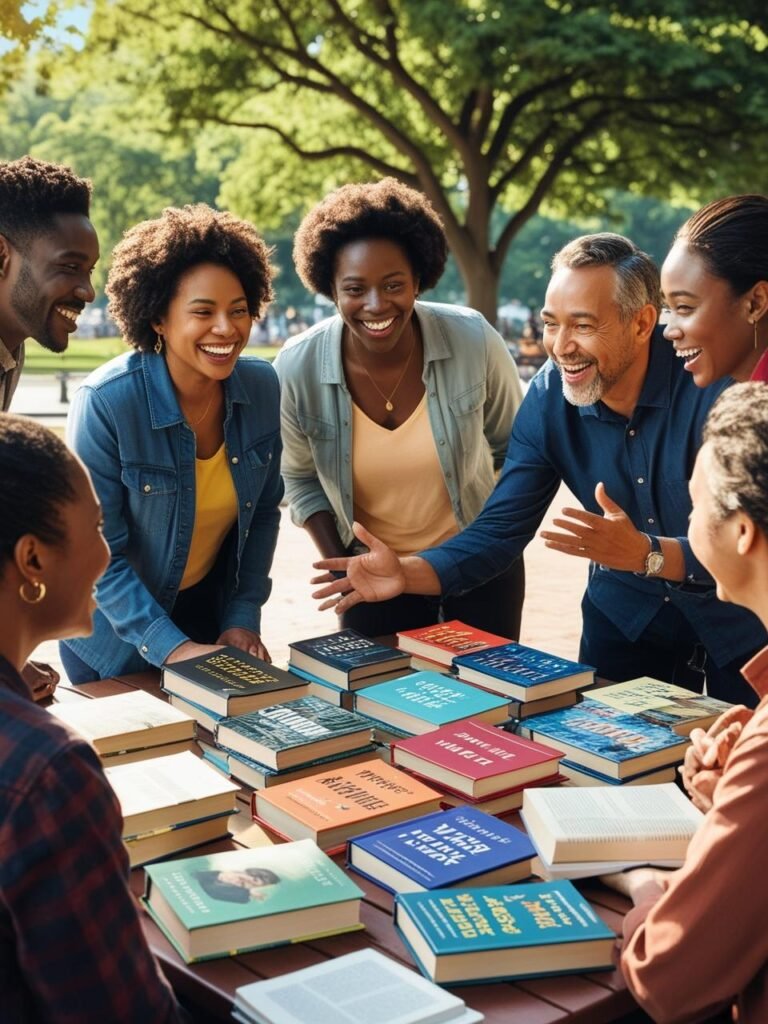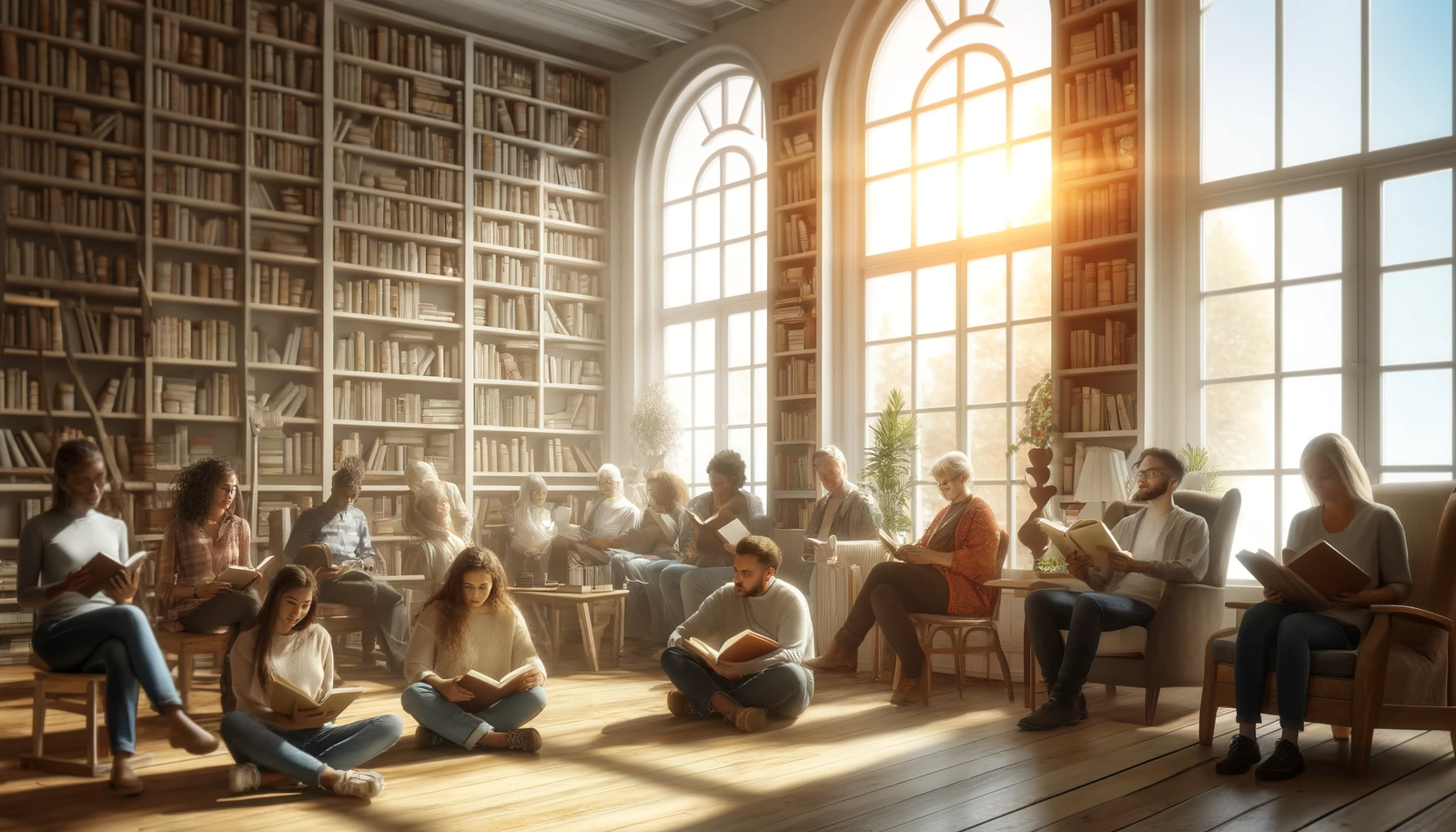The benefits of non-fiction reading go far beyond entertainment; they are profound tools for expanding our minds and enriching our lives. Non-fiction books provide a gateway to understanding the complexities of the world, unlocking new knowledge, and fostering emotional and intellectual resilience. Whether diving into the pages of a memoir, tackling a self-help guide, or exploring the depths of history, non-fiction books offer readers opportunities to grow, reflect, and thrive.
Reading non-fiction has surged in popularity in recent years. According to the Association of American Publishers, non-fiction titles accounted for over 60% of book sales in 2023, a testament to their growing influence. But why are they so impactful? The answer lies in their ability to educate, inspire, and challenge our way of thinking, helping us to cultivate resilience against life’s challenges and build a better understanding of ourselves and the world around us.
In this article, we will delve into the ways non-fiction reading nurtures the mind, fostering both cognitive and emotional growth. By the end, you’ll have a deeper appreciation of the transformative power of non-fiction and how it can empower you to become more resilient and insightful.
What Is Non-Fiction? A Brief Overview
Non-fiction is a literary genre grounded in factual information, offering readers a lens into reality rather than imagined worlds. Unlike fiction, which stems from creative storytelling, non-fiction books aim to educate, inform, or inspire through true events, research, or personal experiences. This category encompasses a diverse array of subgenres, each with its unique appeal and purpose.
Definition and Subcategories of Non-Fiction
Non-fiction can be defined as any written work based on facts, real events, and actual people. Below are some of the most popular subcategories within the genre:
• Biographies and Autobiographies: Narratives about individuals’ lives, offering insight into their experiences and achievements. Example: “Steve Jobs” by Walter Isaacson.
• Memoirs: Personal accounts focusing on specific periods or experiences. Example: “Educated” by Tara Westover.
• Self-Help and Personal Development: Guides for personal growth and skill-building. Example: “Atomic Habits” by James Clear.
• History and Culture: Books that explore historical events and cultural shifts. Example: “Guns, Germs, and Steel” by Jared Diamond.
• Science and Technology: Works that simplify complex scientific concepts. Example: “A Brief History of Time” by Stephen Hawking.
• Business and Productivity: Guides for professional success and organizational strategies. Example: “The Lean Startup” by Eric Ries.
These subgenres demonstrate the versatility of non-fiction, catering to readers with diverse interests and goals.
Non-Fiction vs. Fiction: Understanding the Differences
While fiction provides escapism through imagination, non-fiction builds resilience by grounding readers in reality. Here are some key differences:
Non-fiction and fiction serve different but complementary purposes. A well-rounded reader often benefits from engaging with both, but non-fiction excels in building intellectual and emotional resilience through its focus on real-world insights.
| Aspect | Non-Fiction | Fiction |
| Purpose | Educate, inform, inspire | Entertain, inspire creativity |
| Content | Fact-based, verifiable | Imaginative, often speculative |
| Impact | Expands knowledge, develops critical thinking | Enhances empathy, fosters creativity |
| Examples | Memoirs, self-help, history books | Novels, short stories, fantasy |
The Unique Value of Non-Fiction
What makes non-fiction indispensable is its ability to connect readers with real-world issues, tools, and stories. Consider the following:
• Education and Skill Building: Non-fiction is a treasure trove of actionable knowledge. For example, reading “Deep Work” by Cal Newport can help professionals improve focus and productivity.
• Perspective and Empathy: Memoirs and biographies allow readers to step into others’ shoes, fostering greater understanding of diverse experiences.
• Resilience Against Misinformation: Non-fiction equips readers with critical thinking skills, enabling them to analyze and verify facts effectively.
By understanding its core definition and comparing it with fiction, we see how non-fiction uniquely positions itself as a genre that nurtures growth, understanding, and resilience.
The Cognitive Benefits of Non-Fiction Reading

Non-fiction reading is not just an exercise in acquiring knowledge; it is a mental workout that enhances cognitive abilities and builds resilience in navigating life’s complexities. This section explores how reading non-fiction contributes to intellectual development, sharpens critical thinking skills, and improves memory and focus.
1. Enhancing Knowledge Acquisition
Non-fiction books are unparalleled tools for learning. They offer readers access to a wealth of information, often distilled from years of research or lived experience. Unlike other mediums, books allow deep dives into subjects, providing context, background, and actionable insights.
• Case Study: “Sapiens” by Yuval Noah Harari takes readers on a journey through human history, offering a unique perspective on how humanity has evolved. Readers gain not only historical knowledge but also a better understanding of societal structures.
• Fact: According to a Pew Research Center survey, 73% of adults who read non-fiction say they do so to learn about topics of personal interest or professional development.
Through consistent reading, individuals expand their knowledge bases, becoming more adaptable and resilient in the face of new challenges.
2. Developing Critical Thinking
Non-fiction encourages readers to question, analyze, and synthesize information, fostering critical thinking skills that are crucial for resilience. Readers often engage with arguments, data, and perspectives that challenge their beliefs, prompting them to evaluate evidence and form reasoned conclusions.
Strategies for Developing Critical Thinking Through Non-Fiction:
• Compare multiple books on the same topic to uncover differing viewpoints.
• Reflect on the author’s intent and potential biases.
• Ask questions like, “What evidence supports this claim?” or “What alternative perspectives exist?”
For example, reading books like “Thinking, Fast and Slow” by Daniel Kahneman encourages readers to recognize cognitive biases and improve decision-making, skills that directly contribute to intellectual resilience.
3. Improving Memory and Focus
Reading non-fiction requires sustained attention and comprehension, exercises that naturally enhance memory and focus. When readers actively engage with material, such as by taking notes or summarizing chapters, they reinforce neural connections, improving recall and cognitive stamina.
Tips to Maximize Memory Retention:
• Use the SQ3R Method (Survey, Question, Read, Recite, Review) to process information effectively.
• Take handwritten notes; studies show this aids memory better than typing.
• Review and discuss the material to reinforce learning.
Additionally, neuroscience research shows that the brain forms stronger connections when processing factual information, making it easier to retrieve and apply this knowledge in real-world scenarios.
Supporting Data: How Non-Fiction Impacts Cognitive Abilities
| Cognitive Benefit | Impact of Non-Fiction Reading |
| Knowledge Acquisition | Introduces new concepts, cultures, and disciplines, broadening intellectual horizons. |
| Critical Thinking | Encourages questioning, analysis, and the ability to evaluate arguments and evidence critically. |
| Memory and Focus | Strengthens attention span and information retention through active reading practices. |
Resilience Through Cognitive Growth
By consistently engaging with non-fiction, readers build intellectual resilience—the ability to adapt to new information, navigate complexity, and make informed decisions. Whether exploring scientific breakthroughs, historical analysis, or self-improvement strategies, non-fiction empowers readers to tackle life’s challenges with confidence and clarity.
Building Emotional Intelligence Through Non-Fiction

Non-fiction books play a significant role in developing emotional intelligence, enabling readers to better understand themselves and others. This growth stems from exposure to diverse perspectives, thought-provoking narratives, and practical self-help techniques. By fostering empathy, self-awareness, and resilience, non-fiction empowers readers to navigate personal and social challenges more effectively.
1. Understanding Diverse Perspectives
Reading non-fiction provides a window into the lives and experiences of others, helping readers develop empathy and cultural awareness. Memoirs and biographies are particularly powerful in this regard, as they immerse readers in the intimate details of someone else’s journey.
• Example: “Becoming” by Michelle Obama offers a deeply personal account of her life, from her childhood in Chicago to her time as First Lady. Readers gain insights into her struggles, triumphs, and the resilience she cultivated along the way.
• Fact: Studies from the University of Toronto have shown that reading about real-life experiences enhances empathy by activating the brain’s mirror neuron system, which is responsible for understanding others’ emotions.
Through such books, readers can broaden their horizons, challenging biases and deepening their connection to the world.
2. Addressing Personal Growth and Self-Reflection
Non-fiction books often serve as tools for personal growth, encouraging readers to reflect on their own lives and make positive changes. Self-help and personal development books, in particular, offer actionable strategies to build emotional resilience and overcome obstacles.
• Popular Titles for Personal Growth:
• “Atomic Habits” by James Clear: A practical guide to building better habits and breaking bad ones.
• “The Subtle Art of Not Giving a Fck” by Mark Manson*: A candid exploration of prioritizing values and finding meaning in life.
These books encourage readers to confront challenges with resilience, embrace change, and cultivate a growth mindset.
3. The Role of Non-Fiction in Enhancing Emotional Resilience
Through the guidance of non-fiction, readers learn to navigate emotional difficulties with greater ease. Books on psychology, mindfulness, and emotional intelligence offer frameworks for understanding and managing feelings, reducing stress, and improving relationships.
• Example: “Emotional Intelligence 2.0” by Travis Bradberry and Jean Greaves: This book provides practical strategies for improving emotional intelligence, a key component of resilience in the face of adversity.
Supporting Data: The Impact of Non-Fiction on Emotional Intelligence
| Emotional Skill | How Non-Fiction Helps |
| Empathy | Memoirs and biographies provide insights into others’ emotions and challenges. |
| Self-Awareness | Self-help books encourage readers to reflect on their values, goals, and habits. |
| Emotional Resilience | Psychology-focused non-fiction offers tools for managing stress and building coping skills. |
Quotes and Case Studies
• Quote: “When we read memoirs, we live a thousand lives. Each story makes us more human.” – Unknown
• Case Study: A 2021 Goodreads survey found that readers of memoirs and self-help books reported feeling a 40% improvement in their ability to empathize with others and manage stress.
Resilience Through Emotional Growth
By exploring the emotional landscapes presented in non-fiction, readers gain the tools and insights needed to enhance their emotional intelligence. These skills not only improve personal relationships but also foster resilience in navigating the ups and downs of life.
The Societal Impact of Non-Fiction

Non-fiction books do more than just shape individuals—they play a pivotal role in influencing societies. By addressing pressing global issues, promoting civic responsibility, and inspiring collective action, non-fiction fosters societal resilience and progress. In this section, we’ll explore how non-fiction contributes to the greater good and why it’s an indispensable force for change.
1. Raising Awareness About Global Issues
Non-fiction exposes readers to critical issues affecting our world, from climate change to social justice. These works often illuminate underreported topics, providing context and solutions that inspire action.
• Example: “The Sixth Extinction” by Elizabeth Kolbert examines the ongoing mass extinction caused by human activity. It combines scientific research with compelling storytelling to highlight the urgency of addressing environmental crises.
• Fact: A study by the International Publishers Association found that non-fiction titles addressing climate change saw a 30% increase in sales between 2020 and 2022, reflecting growing public interest.
By educating readers, these books nurture a sense of global responsibility and resilience in tackling complex challenges.
2. Promoting Civic Responsibility
Books on political, economic, and societal systems encourage readers to engage with their communities and participate in meaningful ways. Non-fiction provides frameworks for understanding governance, economics, and activism, empowering readers to drive change.
• Example: “The New Jim Crow” by Michelle Alexander sheds light on systemic racism in the American criminal justice system. It has been credited with influencing grassroots movements and sparking national conversations about racial equity.
• Case Study: After its release, “The New Jim Crow” became a cornerstone resource for activists, leading to the formation of initiatives aimed at criminal justice reform, including the Sentencing Project and Equal Justice USA.
Such books inspire resilience by equipping readers with knowledge and motivation to confront systemic challenges.
3. Inspiring Collective Action
Non-fiction has the power to unite individuals around shared causes, galvanizing movements and driving progress. These books often combine research, personal narratives, and calls to action to mobilize readers.
• Example: “I Am Malala” by Malala Yousafzai chronicles the author’s fight for girls’ education under the Taliban’s oppressive regime. It has inspired global advocacy for education rights.
• Fact: According to the Malala Fund, donations for education initiatives surged by 45% following the book’s publication.
By fostering awareness and solidarity, non-fiction strengthens societal resilience, enabling communities to tackle collective challenges effectively.
Supporting Data: Non-Fiction’s Role in Societal Change
| Area of Impact | Example Book | Outcome |
| Climate Awareness | “The Sixth Extinction” by Elizabeth Kolbert | Increased environmental advocacy and policy discussions. |
| Racial Justice | “The New Jim Crow” by Michelle Alexander | Sparked activism and reforms in criminal justice. |
| Education Advocacy | “I Am Malala” by Malala Yousafzai | Inspired global action for girls’ education rights. |
Quotes and Inspiration
• Quote: “Non-fiction is the voice of reality. It bridges the gap between knowledge and action.” – Anonymous
• Inspiration: Many influential movements, from civil rights to environmental advocacy, trace their roots to impactful non-fiction works.
Resilience Through Societal Awareness
By addressing global issues and promoting civic engagement, non-fiction helps build societal resilience. It empowers individuals to not only understand the challenges facing humanity but also to take actionable steps toward creating a better future. As readers, engaging with non-fiction allows us to become catalysts for positive change in the world.
The Role of Non-Fiction in Professional Growth
Non-fiction books have long been a cornerstone for professional development, offering valuable insights, actionable strategies, and tools to enhance careers. From improving technical skills to fostering leadership and innovation, non-fiction empowers individuals to navigate the complexities of the professional world with confidence and resilience.
1. Skill Development Through Non-Fiction
Professional non-fiction provides specialized knowledge and techniques to build essential skills, whether it’s mastering time management, improving communication, or excelling in industry-specific tasks.
• Example: “Deep Work” by Cal Newport focuses on cultivating focus and eliminating distractions in a world of constant connectivity. This book has become a go-to guide for professionals aiming to boost productivity.
• Fact: According to the Harvard Business Review, 78% of professionals who read non-fiction related to their field report improvements in workplace performance and efficiency.
These books offer frameworks and methodologies that readers can directly apply, fostering resilience in a fast-changing professional landscape.
2. Expanding Industry-Specific Knowledge
Non-fiction serves as an invaluable resource for gaining in-depth understanding of specific industries, technologies, or trends. By staying informed, professionals can anticipate changes, adapt strategies, and remain competitive.
• Example: “The Lean Startup” by Eric Ries introduces a methodology for building innovative companies through iterative product development. It has influenced startups globally and reshaped entrepreneurship education.
• Case Study: The Lean Startup approach was adopted by tech giants like Dropbox and Airbnb, showcasing its effectiveness in fostering resilience through adaptability.
Industry-specific books not only provide insights but also prepare professionals for challenges unique to their fields.
3. Fostering Leadership and Innovation
Leadership-focused non-fiction helps professionals develop the skills needed to inspire teams, drive innovation, and navigate organizational challenges. These books often include real-world examples, case studies, and advice from seasoned leaders.
• Example: “Leaders Eat Last” by Simon Sinek explores the principles of leadership and building trust within teams. It emphasizes the importance of creating resilient, supportive workplace cultures.
• Fact: A LinkedIn Learning Report revealed that leadership and management were among the most in-demand skills in 2023, with 63% of professionals seeking books on the subject.
Leadership books equip readers with the tools to foster resilience within their teams and organizations, enabling long-term success.
Supporting Data: Professional Growth Through Non-Fiction
| Professional Benefit | Example Book | Outcome |
| Productivity Improvement | “Deep Work” by Cal Newport | Increased focus and efficiency in the workplace. |
| Entrepreneurship Skills | “The Lean Startup” by Eric Ries | Adoption of innovative strategies by startups and major corporations. |
| Leadership Development | “Leaders Eat Last” by Simon Sinek | Enhanced team trust and organizational resilience. |
Quotes and Inspiration
• Quote: “The right book at the right time can change your career forever.” – Unknown
• Inspiration: Many of today’s most successful leaders credit their breakthroughs to lessons learned from non-fiction.
Resilience Through Professional Growth
By engaging with non-fiction, professionals gain the skills, knowledge, and inspiration needed to thrive in an ever-evolving workplace. These books empower readers to overcome challenges, innovate, and lead with confidence, ensuring career resilience and long-term success.
Challenges and Critiques of Non-Fiction
While non-fiction offers undeniable benefits, it is not without its challenges and critiques. Understanding these limitations can help readers make informed choices and derive the maximum value from their reading experiences. This section addresses potential pitfalls, such as bias, misinformation, and the overwhelming abundance of non-fiction titles, and offers strategies to navigate them effectively.
1. Potential Bias and Misinformation
Non-fiction is often perceived as objective, but many works are influenced by the author’s perspective, agenda, or limited access to information. Readers must approach non-fiction critically to distinguish fact from opinion or bias.
• Example: Books like “Outliers” by Malcolm Gladwell have been critiqued for overgeneralizing data to fit narratives. While insightful, such works should be read alongside other sources for a more balanced understanding.
• Fact: A Stanford Study of Literacy found that 82% of readers struggle to differentiate between factual content and opinion in online and printed texts.
Strategies to Counter Bias and Misinformation:
• Cross-reference claims with reputable sources or alternative perspectives.
• Research the author’s background, expertise, and potential biases.
• Read books on the same topic by multiple authors to gain a well-rounded view.
2. Overwhelm and Decision Fatigue
The sheer volume of non-fiction books available can make it difficult to choose what to read. Readers may feel paralyzed by options or overwhelmed by dense, technical content.
• Fact: As of 2023, over 500,000 new non-fiction titles were published annually worldwide, according to the International Publishers Association.
• Case Study: Many professionals report abandoning self-help books mid-way due to overly complex or repetitive content.
Tips for Selecting and Managing Non-Fiction Reading:
• Focus on books aligned with your current goals or interests.
• Utilize curated reading lists, such as the New York Times Best Sellers or Goodreads recommendations.
• Choose books with practical summaries or actionable takeaways to avoid overly dense material.
3. Risk of Overspecialization
While deep dives into specific topics can be rewarding, they may lead to overspecialization, limiting exposure to diverse perspectives. Reading broadly across genres and disciplines helps build a more holistic understanding.
• Example: A reader exclusively focused on productivity books may miss out on works about creativity, innovation, or emotional intelligence, all of which are crucial for long-term resilience.
Recommendations for Balanced Reading:
• Alternate between genres or topics to maintain a well-rounded perspective.
• Set a goal to read one book outside your usual interests every few months.
Supporting Data: Common Challenges of Non-Fiction Reading
| Challenge | Impact | Solution |
| Bias and Misinformation | Readers may form skewed opinions based on one-sided narratives. | Cross-reference sources and diversify reading lists. |
| Overwhelm | Difficulty in selecting or completing books due to the sheer volume available. | Use curated lists and prioritize relevance to personal goals. |
| Overspecialization | Limited exposure to diverse topics or viewpoints. | Rotate genres and explore unfamiliar subjects regularly. |
Quotes and Insights
• Quote: “Reading non-fiction demands skepticism as much as curiosity. The balance is key to understanding.” – Unknown
• Inspiration: Many avid readers find that critical engagement with non-fiction builds not only knowledge but also intellectual resilience.
Resilience Through Informed Reading
By acknowledging these challenges and adopting strategies to address them, readers can maximize the benefits of non-fiction while minimizing its potential drawbacks. This critical approach fosters intellectual and emotional resilience, enabling readers to navigate the complexities of modern information landscapes.
How to Incorporate Non-Fiction into Your Life
Incorporating non-fiction reading into your life can be a transformative journey, fostering resilience, expanding knowledge, and nurturing emotional growth. However, making it a sustainable habit requires intentional strategies and thoughtful planning. This section explores how to choose the right books, develop effective reading techniques, and integrate non-fiction into your daily routine.
1. Choosing the Right Books
Selecting the right non-fiction books is key to staying engaged and reaping the benefits. Aligning your choices with your interests, goals, and current challenges ensures the reading experience remains both enjoyable and meaningful.
Tips for Selecting Non-Fiction Books:
• Align with Personal Goals: Identify areas where you want to grow, such as leadership, emotional intelligence, or creativity. For instance, “Atomic Habits” by James Clear is ideal for those aiming to build better habits.
• Explore Recommendations: Utilize trusted sources like Goodreads or New York Times Best Sellers for curated lists.
• Check Reviews: Look for detailed reviews and ratings to gauge a book’s relevance and quality.
Example Categories for Non-Fiction:
• Personal Development: Books like “The Power of Now” by Eckhart Tolle focus on mindfulness and self-awareness.
• Historical Analysis: Titles such as “The Silk Roads” by Peter Frankopan offer in-depth insights into history and culture.
2. Developing Effective Reading Techniques
To fully engage with non-fiction, adopt techniques that enhance comprehension, retention, and application of the material.
Proven Techniques for Non-Fiction Reading:
• Active Reading: Highlight key points, jot down questions, and annotate margins to engage with the text.
• The SQ3R Method: Survey, Question, Read, Recite, Review—an approach that structures your reading for better retention. Learn more about this method here.
• Mind Mapping: Create visual representations of concepts to connect ideas and reinforce understanding.
• Discussion and Application: Share insights with peers or apply concepts to real-life situations to solidify learning.
3. Making Non-Fiction a Habit
Integrating non-fiction into your daily routine helps transform reading into a consistent, rewarding practice. By carving out dedicated time and setting achievable goals, you can make non-fiction an integral part of your life.
Practical Steps for Building a Reading Habit:
• Set Specific Goals: Aim to read for 20–30 minutes daily or complete one book per month.
• Create a Reading Space: Designate a quiet, comfortable area free from distractions.
• Utilize Audiobooks: Leverage platforms like Audible to listen to non-fiction during commutes or workouts.
• Track Your Progress: Use tools like Goodreads or a journal to record and reflect on what you’ve read.
Example Routine:
• Morning: Read a chapter of a motivational book like “Make Your Bed” by Admiral William H. McRaven.
• Afternoon: Listen to a non-fiction audiobook during your commute.
• Evening: Reflect on key takeaways and how they apply to your life.
Supporting Data: Benefits of a Non-Fiction Reading Habit
| Benefit | Impact |
| Consistency Builds Knowledge | Reading 30 minutes daily adds up to 24 books a year on average. |
| Habit Improves Focus | Structured reading enhances attention span and cognitive resilience. |
| Lifelong Learning | Regular reading fosters adaptability and intellectual growth. |
Quotes and Inspiration
• Quote: “A reader today, a leader tomorrow. Resilience starts with learning.” – Anonymous
• Inspiration: Many successful individuals credit daily non-fiction reading with their personal and professional achievements.
Resilience Through Reading Habits
By choosing the right books, applying effective techniques, and integrating reading into your routine, non-fiction becomes a powerful tool for resilience and growth. Whether it’s 10 minutes a day or an entire evening, every page read is a step toward a more knowledgeable and adaptive self.
Conclusion
Non-fiction reading is more than just a pastime—it is a profound investment in personal growth, intellectual development, and societal progress. By exploring real-world issues, uncovering diverse perspectives, and acquiring actionable knowledge, non-fiction books empower readers to build resilience, both as individuals and as members of a global community.
Key Takeaways
1. Cognitive Growth: Non-fiction sharpens critical thinking, enhances memory, and deepens knowledge. It fosters the intellectual resilience needed to navigate complex challenges.
2. Emotional Intelligence: By engaging with memoirs, self-help guides, and psychology-focused books, readers cultivate empathy, self-awareness, and the ability to manage emotions effectively.
3. Societal Impact: Non-fiction raises awareness about global issues and inspires civic responsibility, uniting individuals around shared causes.
4. Professional Development: These books provide tools and strategies for skill-building, leadership, and innovation, helping individuals adapt and thrive in ever-evolving professional landscapes.
5. Habitual Benefits: Incorporating non-fiction into daily life strengthens focus, reinforces learning, and nurtures lifelong adaptability.
f you haven’t already, start your journey with a non-fiction book that resonates with your current goals or interests. Whether it’s understanding history, improving habits, or building leadership skills, there’s a non-fiction book waiting to transform your perspective. Consider exploring popular titles like:
• “Atomic Habits” by James Clear for personal growth.
• “The Lean Startup” by Eric Ries for professional development.
• “Becoming” by Michelle Obama for an inspiring memoir.
Final Thought
Non-fiction is not just about gaining knowledge; it’s about applying what you’ve learned to create meaningful change in your life and the world around you. As you turn each page, you’re not only expanding your horizons but also building the resilience to face life’s uncertainties with clarity and confidence. Start today—your next chapter of growth awaits.
For more insights, check out our related articles: The Benefits of Reading and An In-Depth Look at Themes in Modern Non-Fiction.



